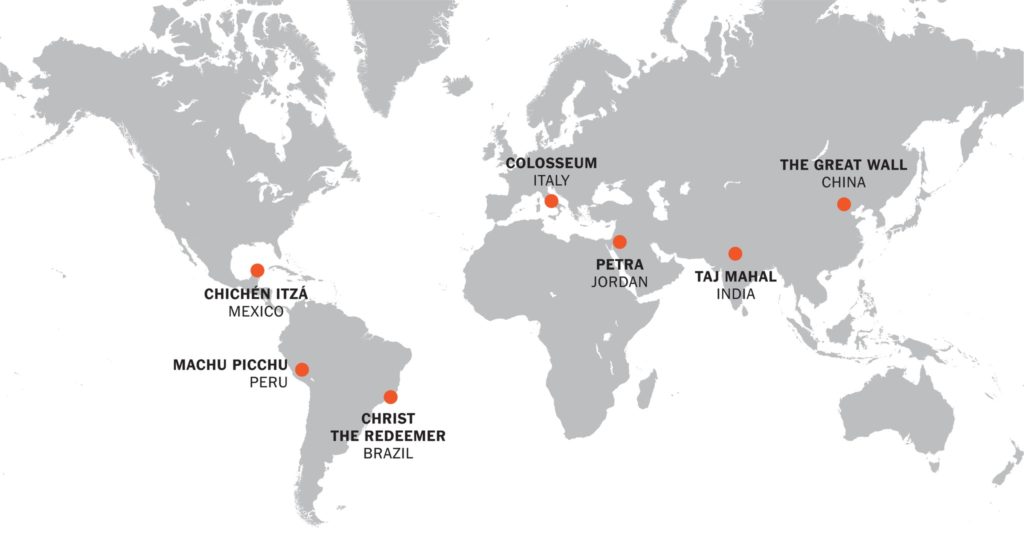The ‘New Seven Wonders of the World’ – NYT – By Veda Shastri, Guglielmo Mattioli and Kaitlyn Mullin – Dec. 1, 2017
Apesar de não ter relação direta com o Projeto Pasárgada, resolvi publicar essa matéria do NYT, que trata das ‘Sete maravilhas modernas do mundo’, pois pretendo visitá-las nos próximos anos, conjugando com a preparação para os concursos da magistratura. Viajando e estudando, esse é o lema!!!
- Cristo Redentor – Rio de Janeiro – Brasil – 15.12.2019
The Great Wall of China. The Taj Mahal. Petra. The Colosseum. Christ the Redeemer. Chichén Itzá. Machu Picchu.
These sites and monuments are popularly known as the “new Seven Wonders of the World,” modern additions to the ancient Seven Wonders laid out by Philo of Byzantium in 250 B.C., which included the hanging gardens of Babylon and the pyramids of Giza. (Of those ancient seven, only the pyramids remain.)
The new wonders were chosen in 2007 through an online contest put on by a Swiss company, the New 7 Wonders Foundation, in which more than tens of millions of people voted. All are Unesco World Heritage sites.
Built on four continents, most by ancient and medieval empires, the sites selected in 2007 are all architectural marvels of enormous scale — and are among the most visited tourist attractions in the world.
What makes a site a wonder? What would you put on this list? We want to hear from you. At the bottom of this page is a form in which you can submit your thoughts.
The Great Wall, China
Built from 220 B.C. to A.D. 1644 by several emperors and dynasties.
TENS OF MILLIONS VISIT EACH YEAR
Now a Chinese national symbol, the vast Great Wall was built over nearly 1800 years. The Great Wall is actually many walls that overlap; the combined length of those layers is estimated to be 10,000 to 20,000 kilometers. The design of the wall, which is constructed across mountain passes and ridges, makes strategic use of the natural terrain. The best preserved portion of the wall runs east to west from southeastern Liaoning Province to northwestern Gansu Province. The Ming dynasty strengthened and maintained these sections from 1368 to 1644.
The Taj Mahal, India
Built 1632-48. Commissioned by the Mughal emperor Shah Jahan.
OVER SIX MILLION VISITORS IN 2016
The Taj Mahal is one of the crowning architectural achievements of the Mughal empire, which ruled most of the Indian subcontinent from 1526 to 1761. It took around 20,000 workers and 16 years to build. The building reflects the Mughal architectural style, stressing symmetry and balance. In recent years, restoration efforts have been focused on protecting the ivory marble facades from pollution.
Petra, Jordan
Built 4th century B.C. to 2nd century A.D. by the Nabatean kingdom.
OVER 450,000 VISITORS IN 2016
The city of Petra was built by the Nabateans, who lived in the Wadi Musa valley for more than 400 years, in a spot strategically located along early silk and spice trade routes. The city fell to the Roman Empire in A.D. 106.
The Hellenistic facades are carved directly into the canyons and use the natural terrain as guides. Today, the monuments are vulnerable to flash flooding in the Wadi Musa and continuing erosion from wind and rain.
The number of visitors to Petra has decreased in recent years, in part because of instability and violence in the Middle East.
The Colosseum, Italy
Built A.D. 72-82. Commissioned by Flavian emperors during the first century of the Roman Empire.
OVER SIX MILLION VISITORS IN 2016
The Colosseum — an amphitheater with arcades and half columns — is an example of the Roman Empire’s architectural innovation. It was used for gladiator and hunting shows, as well as public executions, for four centuries. After the fall of the Roman Empire, it was used temporarily as a housing complex.
Earthquake damage and the mining of the Colosseum’s materials have left just one-third of the original structure in place.
Restoration efforts have been stepped up since the early 19th century. In 2016, a three-year restoration of the building’s facade was completed.
Christ the Redeemer, Brazil
Built 1926-31. Commissioned by the Roman Catholic archdiocese of Rio de Janeiro.
OVER TWO MILLION VISIT EACH YEAR
The Christ the Redeemer statue in Brazil, the most recently constructed of the new Seven Wonders, stands 125 feet tall. At the time the statue was commissioned by the Catholic Church in the early 20th century, over 90 percent of Brazilians were Catholic. Images of the Christ statue are reproduced throughout Brazil.
In order for the statue, which weighs 1,145 tons, to support its massive arm span, it was made with reinforced concrete. It is considered the largest Art Deco sculpture in the world.
Its location, atop a 710-meter-tall mountain, has left it vulnerable to weather and damage from lightning. One of the greatest restoration challenges presented by the statue is matching the color of its six million stone tiles.
Chichén Itzá, Mexico
Built 5th-13th century by the Maya-Toltec civilization.
OVER TWO MILLION VISITORS IN 2016
Chichén Itzá was an ancient Maya city that eventually became part of the Maya-Toltec civilization. It flourished until around A.D. 1200, and later joined a political alliance with the cities of Mayapán and Uxmal. It had already been abandoned by the time the Spanish arrived in the 16th century. Archaeological excavations began in the early 19th century.
The ruins feature religious temples that epitomize Maya innovation in astronomy and science. The Temple of Kukulkán has 365 steps, one for each day in the Haab solar calendar. The temple is crowned by a carving of Kukulkán, also known as Quetzalcoatl, the feathered serpent deity.
Machu Picchu, Peru
Built in the mid-15th century by the Incas.
OVER ONE MILLION VISITORS IN 2016
Machu Picchu is a pre-Columbian Incan settlement, one of the few that remain intact. Situated on the eastern slope of the Andes Mountains, it was probably built as a royal retreat for the Incan emperor Pachacuti Inca Yupanqui, not intended to be visited by the masses. In use from the mid-15th century to the mid-16th century, it was eventually abandoned, although the reason is not clear.
Though the Incan empire was conquered by the Spanish in 1532, the conquistadors did not find the site; it was eventually “discovered” in 1911. The architecture was integrated into the natural terrain, its walls and terraces cut into the rock. Today, it is reached either by hiking up the Incan trail through the Andes or by train.
In order to better preserve the structures, the Peruvian government has started to limit the amount of time tourists may spend at the site.



